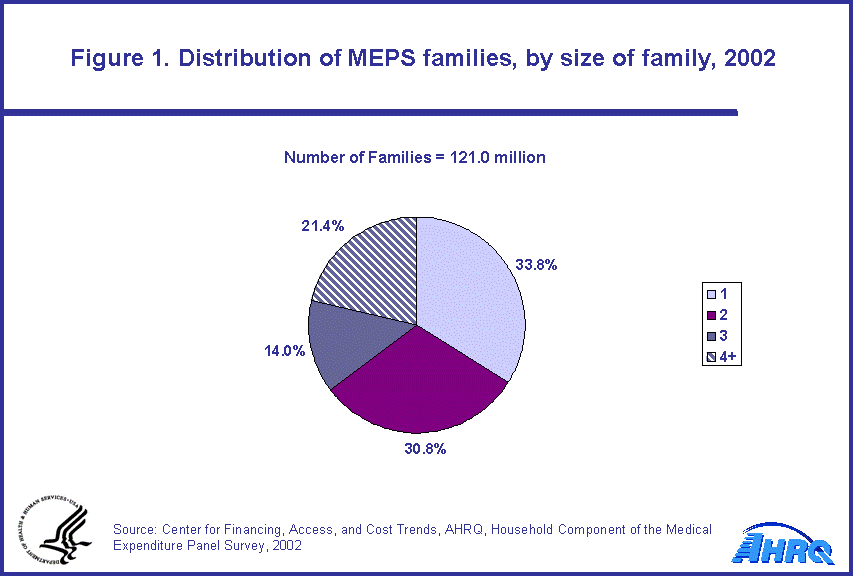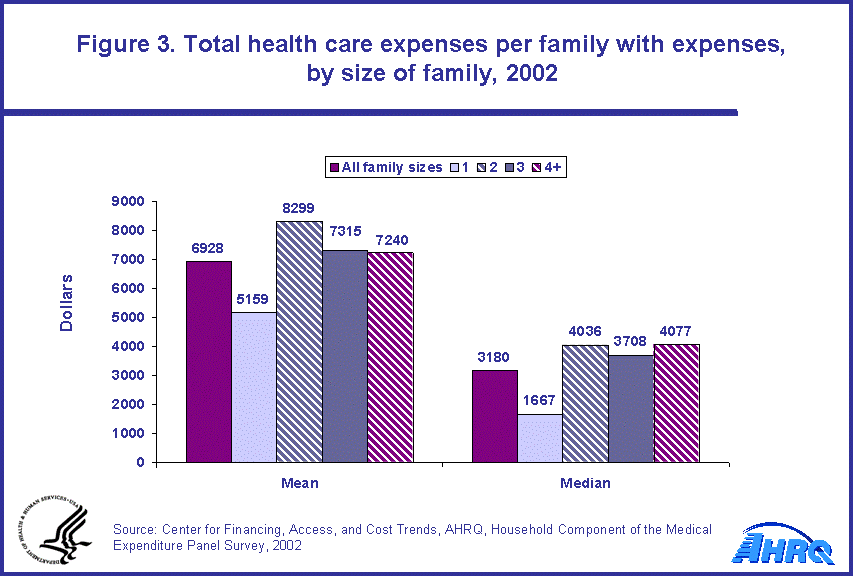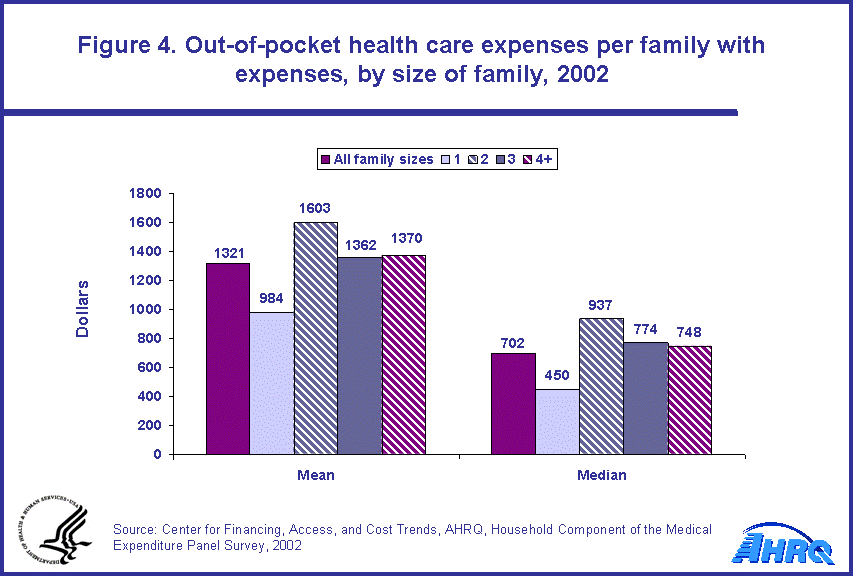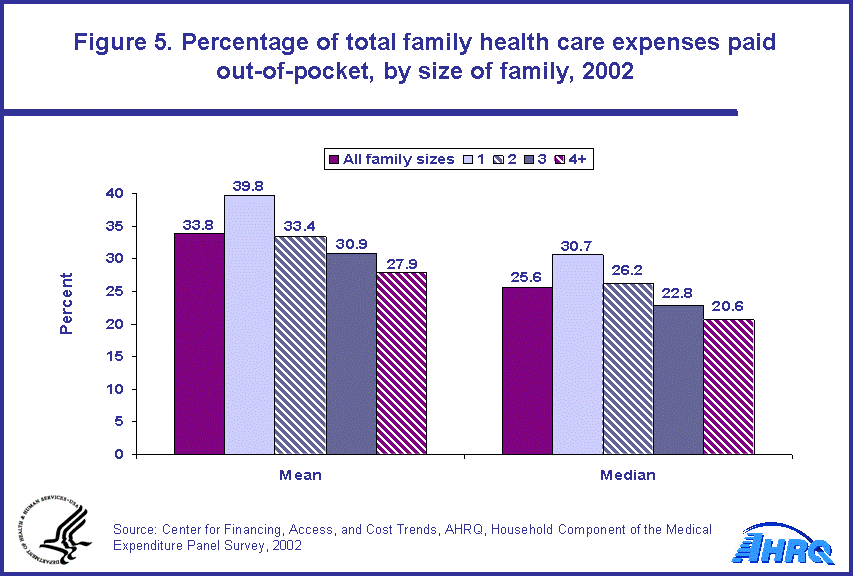
|
|
Font Size:
|
||||
|
|
|
|
||||
STATISTICAL BRIEF #63:
Family Health Care Expenses, by Size of Family, 2002
Highlights
- Overall, about 95 percent of families in 2002 had some health care expenses, and the total expenses for these families averaged $6,928.
- The average amount of expenses paid out-of-pocket per family with expenses was $1,321.
- Both total and out-of-pocket median expenses were approximately half as large as their respective averages.
- Both total and out-of-pocket expenses were substantially lower on average for individual than multiple-person families.
- Larger families tended to pay a smaller proportion of their health care expenses out-of-pocket.
Introduction
The Household Component of the Medical Expenditure Panel Survey (MEPS-HC) is designed to produce nationally representative estimates of the health care use, expenditures, sources of payment, and insurance coverage among the United States civilian noninstitutionalized population. Data from the survey are used by statisticians and researchers to generalize to this population as well as to conduct research in which the family is the unit of analysis. Moreover, MEPS-HC is the only source of information available for estimating the total health care expenses that American families incur each year.
Many factors can influence the level of health care expenses for a family, including the size of the family as well as the demographic, socioeconomic, and health status characteristics of family members. Further, the extent to which persons in the family have health insurance coverage can impact both access to care and the average level of family expenditures.
This Statistical Brief provides descriptive statistics on total and out-of-pocket health care expenses in 2002 for families, by size of family. Family units in MEPS-HC include both persons living together in the same household and individuals living on their own. All differences discussed in this brief are statistically significant at the 0.05 level.
Findings
In 2002, there were approximately 121 million family households in the United States civilian noninstitutionalized population. About one-third (33.8 percent) of family units in MEPS were individuals, 30.8 percent contained two persons, and 35.4 percent contained three or more persons. (figure 1)
The vast majority of families (about 95 percent) had some health care expenses in 2002. However, individual family units were less like to have health care expenses (88.5 percent) than multiple-person families (97.4 to 98.9 percent). (figure 2)
In 2002, the total expenses for families with expenses averaged $6,928 while the median expense ($3,180) was less than half the mean expenditure level (figure 3). The average amount paid out-of-pocket per family with health care expenses was $1,321 while the median of $702 was just over half as large (figure 4). Median health care expenses were substantially lower than mean expenses because a small percentage of families include people who incur a disproportionately large share of total medical expenses.
Both total and out-of-pocket expenses were substantially lower for individual than multiple-person families. The mean total expense was $5,159 for individuals compared to $7,240 or higher for larger families (figure 3) and the average out-of-pocket expense was $984 for individuals compared to $1,362 or higher for larger families (figure 4). Similar patterns across family size are observed for the median estimates.
While differences in median total expenses between two-person and larger families were not statistically significant, mean total expenses for two-person families were approximately $1,000 higher than for larger families (figure 3). Two-person families are substantially more likely to have an elderly member than larger families, which may contribute to their higher average expenses. Both mean and median out-of-pocket expenses were also higher for two-person than larger family units (figure 4). These differences in average expenses between two-person and larger families are based on aggregate expenses for the family and would increase if expressed as averages per person within families.
Overall, families paid an average of about one-third of their health care expenses out-of-pocket, while the median proportion that was paid out-of-pocket was about one-fourth (figure 5). In general, larger families paid a smaller proportion of their expenses out-of-pocket. The mean proportion paid out-of-pocket ranged from 27.9 percent for families with four or more members to 39.8 percent for individuals, while median proportions showed a similar pattern but ranged from 20.6 percent to 30.7 percent.
Data Source
The estimates in this Statistical Brief are based upon data from the MEPS 2002 Full-Year Consolidated Data File: HC-070.
Definitions
Expenditures
Total expenses include payments from all sources to hospitals, physicians, other health care providers (including dental care), and pharmacies for services reported by respondents to the MEPS-HC. Sources include direct payments from individuals, private insurance, Medicare, Medicaid, and miscellaneous other sources. Out-of-pocket expenses include payments by individuals and families for services received by all family members during the year. Premiums for health insurance policies are not included.
Family
A family in MEPS-HC generally consists of two or more persons living together in the same household who are related by blood, marriage, or adoption, as well as foster children. Other types of family units include unmarried persons living together who consider and report themselves a family unit and single persons living with neither a relative nor a person identified as a "significant other." Relatives identified as usual residents of the household who were not present at the time of the interview, such as college students living away from their parents' home during the school year, are considered as members of the family that identified them. All families with one or more members living in the civilian noninstitutionalized population for any part of the year are included in the estimates.
About MEPS-HC
MEPS-HC is a nationally representative longitudinal survey that collects detailed information on health care utilization and expenditures, health insurance, and health status, as well as a wide variety of social, demographic, and economic characteristics for the civilian noninstitutionalized population. It is cosponsored by the Agency for Healthcare Research and Quality and the National Center for Health Statistics.
For details on how to create family-level estimates, see the documentation for any MEPS full-year person-level public use file (e.g., HC-070 for 2002 estimates presented in this Statistical Brief).
For more information about MEPS, call the MEPS information coordinator at AHRQ (301-427-1406) or visit the MEPS Web site at http://www.meps.ahrq.gov/.
References
For a detailed description of the MEPS-HC survey design, sample design, and methods used to minimize sources on nonsampling error, see the following publications:
Cohen, J. Design and Methods of the Medical Expenditure Panel Survey Household Component. MEPS Methodology Report No. 1. AHCPR Pub. No. 97-0026. Rockville, Md.: Agency for Health Care Policy and Research, 1997.
Cohen, S. Sample Design of the 1996 Medical Expenditure Panel Survey Household Component. MEPS Methodology Report No. 2. AHCPR Pub. No. 97-0027. Rockville, Md.: Agency for Health Care Policy and Research, 1997.
Suggested Citation
Machlin, S. R. and Zodet, M. W. Family Health Care Expenses, by Size of Family, 2002. Statistical Brief #63. January 2005. Agency for Healthcare Research and Quality, Rockville, MD. http://meps.ahrq.gov/mepsweb/data_files/publications/st63/stat63.shtml
 |
||||||||||||||||||
Source: Center for Financing, Access, and Cost Trends, AHRQ, Household Component of the Medical Expenditure Panel Survey, 2002 | ||||||||||||||||||
|
|
||||||||||||||||||
 |
||||||||||||||||||
Source: Center for Financing, Access, and Cost Trends, AHRQ, Household Component of the Medical Expenditure Panel Survey, 2002 | ||||||||||||||||||
|
|
||||||||||||||||||
 |
||||||||||||||||||
Source: Center for Financing, Access, and Cost Trends, AHRQ, Household Component of the Medical Expenditure Panel Survey, 2002 | ||||||||||||||||||
|
|
||||||||||||||||||
 |
||||||||||||||||||
Source: Center for Financing, Access, and Cost Trends, AHRQ, Household Component of the Medical Expenditure Panel Survey, 2002 | ||||||||||||||||||
|
|
||||||||||||||||||
 |
||||||||||||||||||
Source: Center for Financing, Access, and Cost Trends, AHRQ, Household Component of the Medical Expenditure Panel Survey, 2002 | ||||||||||||||||||
|
|


